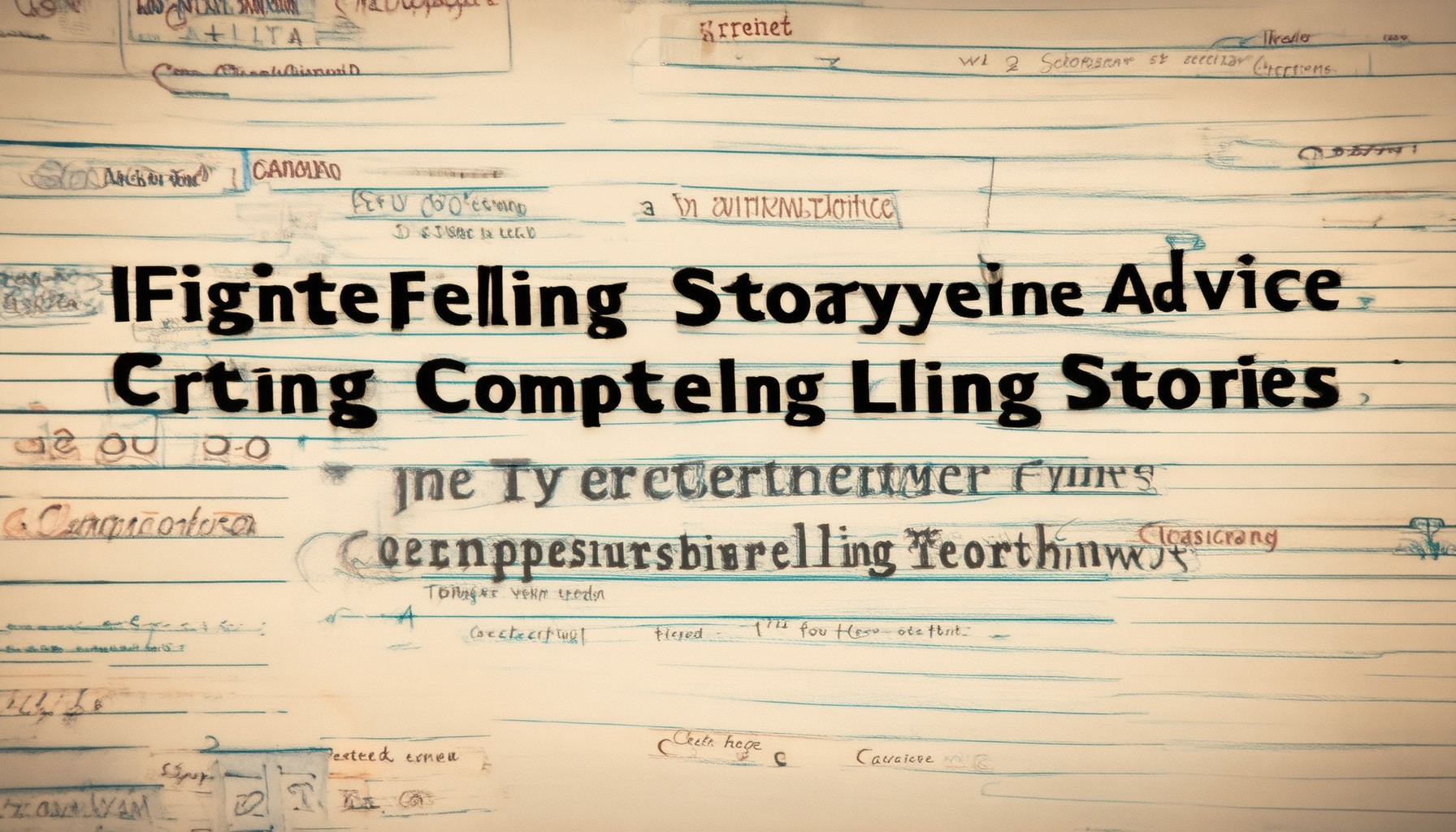Fiction storytelling has long been a cornerstone of entertainment, offering readers immersive worlds, relatable characters, and compelling narratives. For those eager to craft their own tales, seeking effective fiction storytelling advice is essential to creating stories that resonate. Whether you’re a seasoned writer or just beginning, mastering the art of fiction storytelling involves understanding key elements, developing memorable characters, and structuring plots that captivate audiences. This guide delves into the fundamental aspects of fiction storytelling, providing practical tips and insights to help you craft compelling stories that leave a lasting impact.
Key Takeaways
- Develop relatable, multi-dimensional characters with clear motivations and growth arcs.
- Utilize a strong narrative framework, such as the three-act structure, to maintain engagement.
- Create immersive settings that enhance the story’s authenticity.
- Balance action and description to match the story’s tone and keep readers invested.
- Use vivid imagery and sensory details to paint scenes in the reader’s mind.
- Drive the narrative with meaningful conflict and high stakes.
- Choose the right perspective to deepen emotional investment.
- Infuse stories with underlying themes and symbols for depth and resonance.
- Write conversations that reveal character traits and advance the plot naturally.
- Polish the work through multiple drafts and seek feedback for improvement.
- Engage with readers to build loyalty and understand their preferences.
- Maintain a healthy routine to sustain creativity and avoid burnout.
- Read widely and explore diverse genres to fuel creative ideas.
- Use criticism as a tool for growth and refinement.

The Key Elements of Effective Fiction Storytelling
Here are the key elements that make fiction storytelling impactful and memorable:
- Characters : Develop relatable and multi-dimensional characters. A well-crafted protagonist with a clear motivation and a supporting cast with their own arcs can draw readers in and create emotional connections.
- Plot Structure : Utilize a strong narrative framework. The classic three-act structure (setup, confrontation, resolution) provides a solid foundation, though flexible structures like the four-act or “save-the-last-scene” method can also work effectively.
- World-Building : Create an immersive environment. Whether it’s a realistic setting or a fantastical world, detail matters. Establish a believable setting with unique characteristics that enhance the story.
- Pacing : Balance between slow and fast. Maintain a steady rhythm that matches the story’s tone, ensuring moments of tension and reflection alternate with moments of action and discovery.
- Imagery and Descriptive Language : Use vivid imagery and sensory details to paint scenes in the reader’s mind. Strong descriptive language enhances atmosphere and helps readers visualize the story world.
- Conflict and Stakes : Drive the narrative forward with meaningful conflict. Clear antagonists and high stakes keep readers engaged and invested in the outcome.
- Point of View (POV) : Choose the right perspective to tell your story. Limited POV deepens emotional investment, while multiple POVs allow for varied storytelling angles.
- Themes and Symbolism : Infuse your story with underlying themes or symbols. These elements add depth and resonance, allowing readers to connect on a higher level.
By focusing on these elements, you can craft a compelling and engaging story that captures the hearts of your readers.
The Key Elements of Effective Fiction Storytelling
Here are the key elements that make fiction storytelling impactful and memorable:
- Characters : Develop relatable and multi-dimensional characters. A well-crafted protagonist with a clear motivation and a supporting cast with their own arcs can draw readers in and create emotional connections.
- Plot Structure : Utilize a strong narrative framework. The classic three-act structure (setup, confrontation, resolution) provides a solid foundation, though flexible structures like the four-act or “save-the-last-scene” method can also work effectively.
- World-Building : Create an immersive environment. Whether it’s a realistic setting or a fantastical world, detail matters. Establish a believable setting with unique characteristics that enhance the story.
- Pacing : Balance between slow and fast. Maintain a steady rhythm that matches the story’s tone, ensuring moments of tension and reflection alternate with moments of action and discovery.
- Imagery and Descriptive Language : Use vivid imagery and sensory details to paint scenes in the reader’s mind. Strong descriptive language enhances atmosphere and helps readers visualize the story world.
- Conflict and Stakes : Drive the narrative forward with meaningful conflict. Clear antagonists and high stakes keep readers engaged and invested in the outcome.
- Point of View (POV) : Choose the right perspective to tell your story. Limited POV deepens emotional investment, while multiple POVs allow for varied storytelling angles.
- Themes and Symbolism : Infuse your story with underlying themes or symbols. These elements add depth and resonance, allowing readers to connect on a higher level.
By focusing on these elements, you can craft a compelling and engaging story that captures the hearts of your readers.

The Key Elements of Effective Fiction Storytelling
Here are the key elements that make fiction storytelling impactful and memorable:
- Characters : Develop relatable and multi-dimensional characters. A well-crafted protagonist with a clear motivation and a supporting cast with their own arcs can draw readers in and create emotional connections.
- Plot Structure : Utilize a strong narrative framework. The classic three-act structure (setup, confrontation, resolution) provides a solid foundation, though flexible structures like the four-act or “save-the-last-scene” method can also work effectively.
- World-Building : Create an immersive environment. Whether it’s a realistic setting or a fantastical world, detail matters. Establish a believable setting with unique characteristics that enhance the story.
- Pacing : Balance between slow and fast. Maintain a steady rhythm that matches the story’s tone, ensuring moments of tension and reflection alternate with moments of action and discovery.
- Imagery and Descriptive Language : Use vivid imagery and sensory details to paint scenes in the reader’s mind. Strong descriptive language enhances atmosphere and helps readers visualize the story world.
- Conflict and Stakes : Drive the narrative forward with meaningful conflict. Clear antagonists and high stakes keep readers engaged and invested in the outcome.
- Point of View (POV) : Choose the right perspective to tell your story. Limited POV deepens emotional investment, while multiple POVs allow for varied storytelling angles.
- Themes and Symbolism : Infuse your story with underlying themes or symbols. These elements add depth and resonance, allowing readers to connect on a higher level.
By focusing on these elements, you can craft a compelling and engaging story that captures the hearts of your readers.

The Key Elements of Effective Fiction Storytelling
Here are the key elements that make fiction storytelling impactful and memorable:
- Characters : Develop relatable and multi-dimensional characters. A well-crafted protagonist with a clear motivation and a supporting cast with their own arcs can draw readers in and create emotional connections.
- Plot Structure : Utilize a strong narrative framework. The classic three-act structure (setup, confrontation, resolution) provides a solid foundation, though flexible structures like the four-act or “save-the-last-scene” method can also work effectively.
- World-Building : Create an immersive environment. Whether it’s a realistic setting or a fantastical world, detail matters. Establish a believable setting with unique characteristics that enhance the story.
- Pacing : Balance between slow and fast. Maintain a steady rhythm that matches the story’s tone, ensuring moments of tension and reflection alternate with moments of action and discovery.
- Imagery and Descriptive Language : Use vivid imagery and sensory details to paint scenes in the reader’s mind. Strong descriptive language enhances atmosphere and helps readers visualize the story world.
- Conflict and Stakes : Drive the narrative forward with meaningful conflict. Clear antagonists and high stakes keep readers engaged and invested in the outcome.
- Point of View (POV) : Choose the right perspective to tell your story. Limited POV deepens emotional investment, while multiple POVs allow for varied storytelling angles.
- Themes and Symbolism : Infuse your story with underlying themes or symbols. These elements add depth and resonance, allowing readers to connect on a higher level.
By focusing on these elements, you can craft a compelling and engaging story that captures the hearts of your readers.
What Are the Best Practices for Creating Compelling Fiction Stories?
To craft compelling fiction, consider the following proven strategies:
1. Develop Relatable Characters
Create characters that resonate with readers by giving them depth, flaws, and relatable motivations. Use detailed descriptions to bring them to life and show their growth throughout the story.
2. Craft a Strong Plot Structure
A well-structured plot ensures engagement. Use a clear beginning, middle, and end, with subplots that complement the main narrative. Maintain pacing to keep readers invested.
3. Utilize Setting and World-Building
Immerse readers by creating a believable setting. Whether it’s a historical era, futuristic city, or imaginary world, detail your environment to enhance the story’s authenticity.
4. Build Suspense and Conflict
Keep readers hooked by introducing conflicts, mysteries, and challenges. Use tension to drive the story forward and create emotional connections with your audience.
5. Write Memorable Dialogue
Make dialogue feel natural and purposeful. Use it to reveal character traits, advance the plot, or deepen the reader’s connection to the story.
6. Edit and Revise Thoughtfully
Polish your work through multiple drafts, focusing on clarity, grammar, and pacing. Seek feedback to identify strengths and areas for improvement.
7. Stay Connected to Your Audience
Engage with readers through social media, newsletters, or community events to build loyalty and gain insights into what resonates with them.
8. Balance Work and Personal Life
Maintain a healthy routine that allows creativity to flourish. Set boundaries to prevent burnout and ensure consistent progress on your projects.
9. Keep Inspiration Alive
Read widely, explore diverse genres, and stay curious about the world around you. Let these experiences inspire fresh ideas and approaches to your writing.
10. Embrace Feedback Constructively
Welcome criticism as a tool for growth. Use it to refine your craft and make informed decisions about your work.
By applying these practices, you can create stories that captivate readers and leave a lasting impact. Remember, the key is to stay dedicated and continuously evolve as a writer.
Explore more tips on crafting compelling stories .

What are the key elements essential for crafting compelling fiction stories?
To craft compelling fiction, several key elements come together to create engaging narratives. Here’s a breakdown of the essential components:
- Plot Development
-
- A strong premise that hooks readers from the beginning.
- Well-defined protagonist with a clear motivation and conflict.
- Conflict or challenge that drives the story forward.
- Progression of events leading to a satisfying resolution.
- Subplots that complement the main storyline.
-
Characterization
-
- Protagonist with depth, flaws, and relatable qualities.
- Supporting characters that add dimension to the story.
- Character arcs that evolve over the course of the narrative.
- Consistent tone of voice matching the protagonist’s personality.
-
Setting
-
- Immersive world-building that enhances the story.
- Use of setting to reflect the mood and themes of the story.
- Attention to detail in describing environments.
- How setting influences character behavior and decisions.
-
Themes and Motifs
-
- Central theme driving the story’s message or meaning.
- Recurring motifs that reinforce the theme.
- Symbolism used to convey deeper meanings.
- Themes that resonate with the target audience.
-
Pacing
-
- Balancing action with descriptive passages.
- Building suspense through careful pacing.
- Creating a rhythm that keeps readers engaged.
- Timing plot twists and reveals effectively.
-
Dialogue
-
- Conversations that reveal character traits.
- Dialects and speech patterns consistent with characters.
- Dialogue that advances the plot or reveals important information.
- Engaging and realistic interactions.
-
Imagery and Description
-
- Vivid descriptions that paint a mental picture.
- Imagery that complements the overall mood.
- Use of sensory details to immerse readers.
- Description that aligns with the genre and tone.
-
Editing and Refinement
-
- Multiple drafts to refine the story.
- Critique and feedback to identify improvements.
- Polishing for clarity, grammar, and flow.
- Final touches to ensure the story’s polished and ready.
By masterfully combining these elements, authors can create stories that captivate readers, evoke emotions, and leave a lasting impression. To explore more tips and insights, visit James Whitfield Thomson and discover expert storytelling advice tailored for aspiring writers.





0 Comments